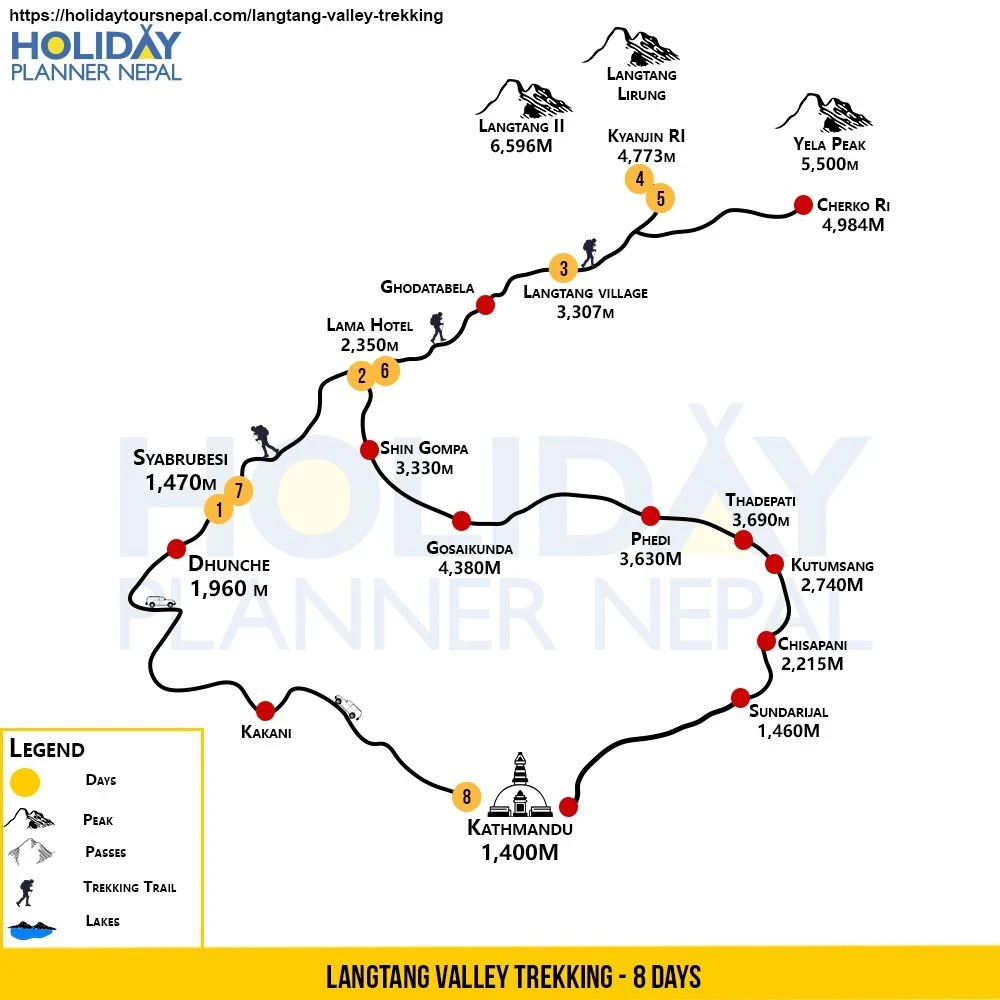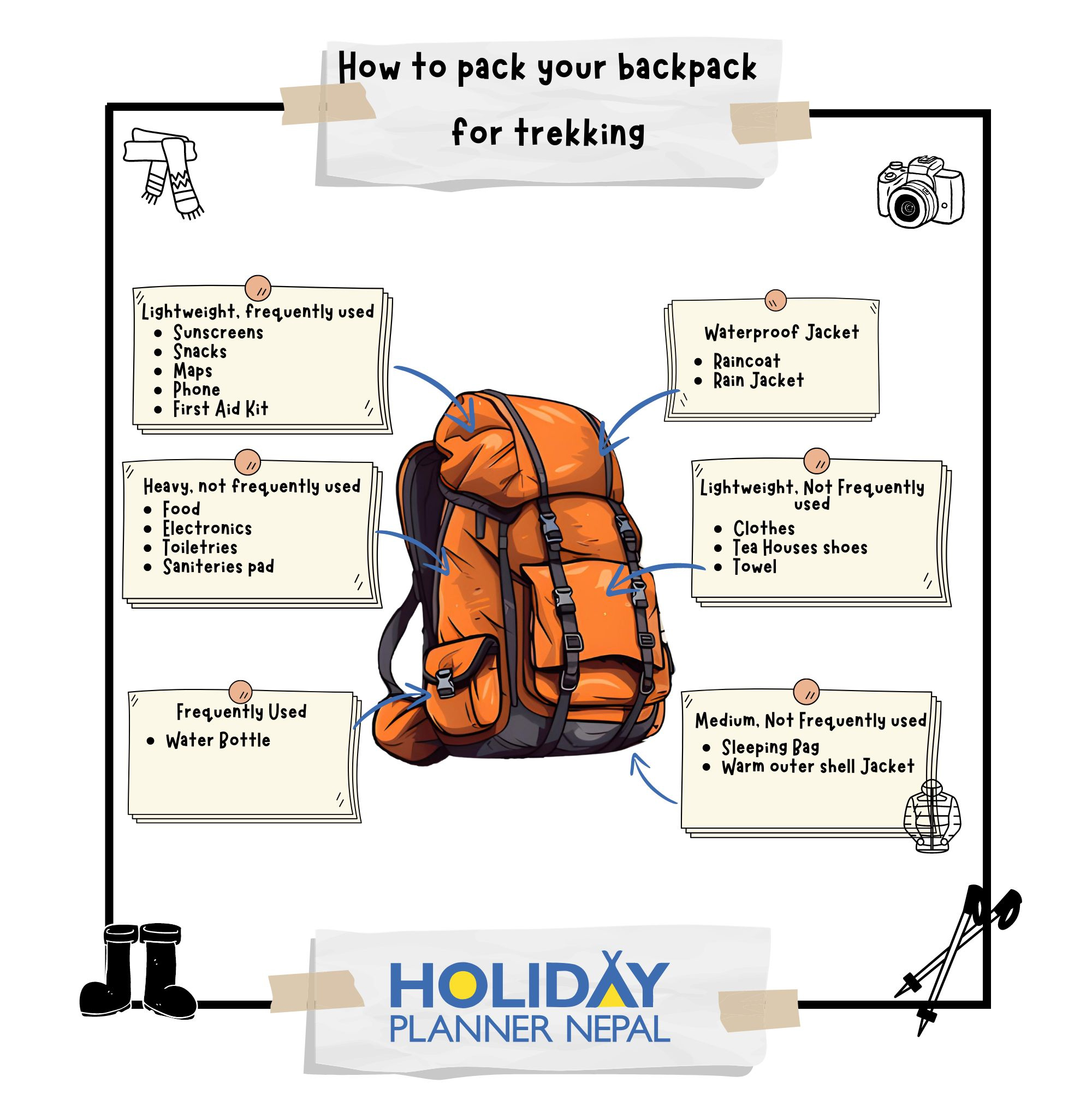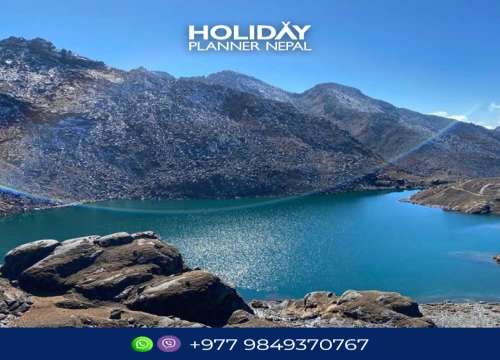Highlights of Langtang Valley Trekking
- The earthquake destroyed the original Langtang Valley following the avalanche from Langtang Lirung, and the valley has been reconstructed.
- Walking around with a panoramic view of the Jugal Himal range and Langtang-Ganesh Himal
- Witness the Breathtaking beauty of sweeping, verdant hills and mountains in a stunning setting.
- Discover old, traditional rituals and Buddhist communities' fascinating culture.
- Trekking into Kyanjin Gompa's picturesque Langtang valley, encircled by towering snow-capped hills, is an experience one will never forget.
- Homeland of Rare birdlife and numerous wild species, including the rare and elusive red pandas and snow leopards.

Major Attractions of the Langtang Valley Trek
1. Kyanjin Gompa (3,870m) – Heart of Langtang
The spiritual and cultural center of the region. This centuries-old Buddhist monastery sits surrounded by glaciers and towering peaks. It’s also the best base for day hikes.
2. Kyanjin Ri & Tserko Ri Viewpoints
These two Himalayan viewpoints offer some of the most dramatic panoramas in Nepal:
Kyanjin Ri (4,773m) – Shorter, great for sunrise
Tserko Ri (4,984m) – 360° views of Langtang Lirung, Dorje Lakpa & more
Perfect for trekkers wanting a summit-like experience without technical climbing.
3. Langtang Lirung (7,227m) – The Giant of the Region
The valley is shadowed by this massive peak, offering stunning views throughout the trek. It’s one of the main visual highlights of Langtang.
4. Tamang & Tibetan Culture
The trail passes through traditional Tamang villages such as:
Syabrubesi
Lama Hotel
Langtang Village
Kyanjin
Trekkers experience authentic Buddhist culture, prayer wheels, monasteries, mani walls, and warm hospitality.
5. Rebuilt Langtang Village
A symbol of strength and resilience after the 2015 earthquake. Visiting the new village and memorial area is both meaningful and educational.
6. Lush Forests & Wildlife in Langtang National Park
The region is rich in biodiversity. Highlights include:
Rhododendron & oak forests
Red pandas (rare sightings)
Himalayan monal
Langur monkeys
Waterfalls & river valleys
7. Yak Cheese Factory
Kyanjin has one of Nepal’s oldest yak cheese factories. Trekkers can visit, taste fresh yak cheese, and learn about Himalayan dairy traditions.
8. Langtang Glacier & Ice Fields
Known as the “Valley of Glaciers,” the region is filled with icefalls, frozen rivers, and glacial formations — especially close to Kyanjin.
9. Authentic Tea-House Trail
This trek offers traditional tea-house stays where trekkers can enjoy:
Local meals
Cultural interaction
Cozy mountain lodges
All without the big crowds found in Everest or Annapurna.
10. Scenic Drive Through the Himalayas
The journey to Syabrubesi offers:
Terraced fields
River gorges
Local villages
Himalayan foothill scenery
A beautiful introduction before the trek begins.
Why Choose the Langtang Valley Trek?
The Langtang Valley Trek is one of Nepal’s most rewarding short treks, offering a perfect blend of Himalayan scenery, Tamang culture, and accessible adventure. It’s often called the “Valley of Glaciers” because the region is surrounded by towering snow peaks and rich in glacial landscapes — all within a few days of Kathmandu.
1. Closest Himalayan Trek from Kathmandu
Langtang is the nearest major trekking region to Kathmandu. A scenic 6–7 hour drive takes you directly to Syabrubesi, the trek’s starting point. No flights required, making it:
Cheaper
Less risky (no weather delays)
Perfect for trekkers with limited time
2. Stunning Mountain Views in a Short Time
In just 3–4 trekking days, you reach the alpine zone with views of:
Langtang Lirung
Dorje Lakpa
Gangchempo
Yala Peak
The landscapes shift quickly from forests and rivers to high meadows and glaciers.
3. Rich Tamang and Tibetan Culture
The region is home to the Tamang and Tibetan-influenced communities. Trekkers enjoy:
Traditional stone houses
Buddhist monasteries
Local yak cheese factories
Friendly hospitality
It feels cultural without the heavy crowds of Everest or Annapurna.
4. Fewer Crowds, Peaceful Trails
Langtang sees fewer trekkers compared to other famous routes. That means a more relaxed, personal experience — ideal for nature lovers who prefer quiet trails and authentic village life.
5. Kyanjin Gompa & Optional Peak Climb
The highlight is Kyanjin Gompa (3,870m). From here, you can do day hikes to:
Kyanjin Ri (4,773m) — best sunrise spot
Tserko Ri (4,984m) — panoramic 360° views
Both are achievable for beginners with decent fitness.
6. Perfect for Short Holidays
The entire trek can be completed in 7–10 days, making it a top choice for people who want a Himalayan experience without committing to long itineraries.
7. Affordable Trek
With no internal flights and shorter duration, Langtang is budget-friendly compared to Everest or Annapurna. Tea-house accommodation and local food make it even more economical.
8. Safe & Well-Developed After the Earthquake
The Langtang region has been rebuilt stronger after 2015. Trails, lodges, and infrastructure are improved, making it a safe and comfortable trekking region today.
Where does the Langtang Valley Trek begin and end?
Langtang Valley Trek is a captivating adventure in the Langtang Region of Nepal, known for its stunning natural beauty and cultural experiences. Langtang Valley begins in the picturesque village of Syabrubeshi, situated at an elevation of 1,500 meters (4,920 feet). To reach Syabrubeshi, trekkers typically embark on a scenic 6-hour road drive from Kathmandu, passing through the Trishuli River valley and the town of Dhunche at an elevation of 1,960 meters. This drive serves as the initial leg of the journey, offering travelers a glimpse of Nepal's diverse landscapes.
Adventurers commence their on-foot journey, making their way to Lama Hotel at an altitude of 2,410 meters. The trail meanders through lush forests, small villages, and alongside the Langtang River, providing a taste of the natural beauty that awaits in the valley.
As the trek progresses, hikers reach Langtang village, perched at 3,430 meters. Here, they can immerse themselves in the local culture, interact with friendly villagers, and appreciate the stunning mountain scenery that surrounds the area.
Trekkers to Kyanjin Gompa, situated at 3,830 meters, serve as a journey highlight. This sacred place is a spiritual center and offers breathtaking vistas of nearby peaks and glaciers.
After a rest day for acclimatization, the descent begins with a return trek to the Lama Hotel, where the altitude is a more comfortable 2,410 meters. The journey back allows trekkers to see familiar sights from a different perspective.
The trek returns to its starting point as adventurers return to Syabrubeshi, where it officially concludes. This village offers a glimpse into the lifestyle of the locals and a chance to unwind after the trek.
At last, trekkers board transportation for a return drive to Kathmandu, ending this incredible journey. This itinerary showcases the full circle of the Langtang Valley Trek, from its starting point in Syabrubeshi to its return to the bustling capital city of Kathmandu, with each day offering unique experiences in this enchanting region of Nepal.

Distance & Altitude coverage of Langtang valley trekking
Day | Activity | Altitude (m/ft) | Distance (km/miles) | Duration (hours) | Elevation Gain (m/ft) | Elevation Loss (m/ft) |
01 | Drive to Syabrubesi via Trishuli and Dhunche Town | 1,500 m / 4,920 ft | 117 km / 73 miles | 6 | 150 m / 492 ft | - |
02 | Trek to Lama Hotel | 2,410 m / 7,905 ft | 11 km / 6.8 miles | 6 | 910 m / 2,986 ft | - |
03 | Trek to Langtang Village | 3,430 m / 11,253 ft | 14 km / 8.7 miles | 5 | 1,020 m / 3,348 ft | - |
04 | Trek to Kyanjin Gompa | 3,830 m / 12,565 ft | 7 km / 4.3 miles | 4 | 400 m / 1,312 ft | - |
05 | Rest Day: Acclimatization and hiking around | 3,830 m / 12,565 ft | Varies (short hikes) | Varies (3–5 hours) | Depends on hike | Depends on hike |
06 | Trek back to Lama Hotel | 2,410 m / 7,905 ft | 21 km / 13 miles | 6 | - | 1,420 m / 4,660 ft |
07 | Trek to Syabrubesi | 1,500 m / 4,920 ft | 11 km / 6.8 miles | 6 | - | 910 m / 2,986 ft |
08 | Drive back to Kathmandu and transfer to the hotel | 1,350 m / 4,430 ft | 117 km / 73 miles | 6 | - | 150 m / 492 ft |
Outline Langtang Valley Trekking Itinerary
- Day 1 Drive to Syabrubeshi (1,500 m/4,920 ft) via Trishuli and Dhunche Town (2,030 m/6,660 ft): 06 hrs.
- Day 2 Trek to Lama Hotel (2,410 m) - 06 hrs.
- Day 3 Trek to Langtang village (3, 430m) - 05 hrs.
- Day 4 Trek to Kyanjin Gompa (3,830 m) - 04 hours.
- Day 5: Rest Day for acclimatization and hiking around.
- Day 6 Trek to Lama Hotel (2,410 m) - 06 hrs.
- Day 7 Trek to Syabrubeshi 1,500m - 06 hours walk.
- Day 8 Drive back to Kathmandu (1350 m/ 4430 ft) and transfer to respective hotels.




 General
General Upper Body
Upper Body Torso
Torso Lower Body
Lower Body Hands
Hands Feet
Feet Undergarments and Inner Wears
Undergarments and Inner Wears First Aid Kits and Medications
First Aid Kits and Medications Other Essentials
Other Essentials




